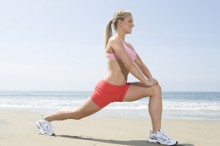 According to the NIH: National Institute of Arthritis and Musculoskeletal and Skin Diseases, back pain affects 8 out of 10 people at some point in their lives.
According to the NIH: National Institute of Arthritis and Musculoskeletal and Skin Diseases, back pain affects 8 out of 10 people at some point in their lives.
Most back pain eventually goes away on its own, but it may take quite a while.
Resting your back and taking over-the-counter pain relievers may help, however staying in bed for more than a day or two can sometimes make the pain worse.
Did you know that a tight psoas could be causing that back pain?
The psoas muscle is a major hip flexor, located deep to the abdominal contents and spans from the upper portion of the femur to the lumbar vertebrae.
It affects our posture and helps to stabilize our spine.
The psoas enables you to walk and run.
Every time you lift your knee, it contracts. When your leg swings back, the psoas lengthens.
The psoas often gets short from all the sitting that we do.
If your psoas is tight and in a contracted state, it will bring your lower back forward, moving you into an anterior tilt: creating a lordotic curve.
This pressure can ultimately compress the joints and discs of the lumbar vertebrae and causes degeneration and will make them more susceptible to injury.
So regularly stretching your psoas can help prevent future injuries from occurring, or mend a chronically tight one.
To effectively stretch the hip flexors, first kneel on your right knee, with toes down, and place your left foot flat on the floor in front of you.
Place both hands on your left thigh and press your hips forward until you feel a good stretch in the hip flexors.
Contract your abdominals and slightly tilt your pelvis back while keeping your chin parallel to the floor.
Hold this pose for 20 to 30 seconds, and then switch sides.
The short video below shows an Atlanta-based chiropractor and former Olympic athlete demonstrating the proper way to Stretch the Psoas.
Helpful tips: Remember to tilt the pelvis back and flatten the spine.
If you’d like to loosen and unlock your tight hip flexors then click here!
Sources: Medline Plus, Stronglifts, Runnersworld
You might also like:
If You Have Lower Back Pain Left Side Above Buttock – Do These 9 Exercises


